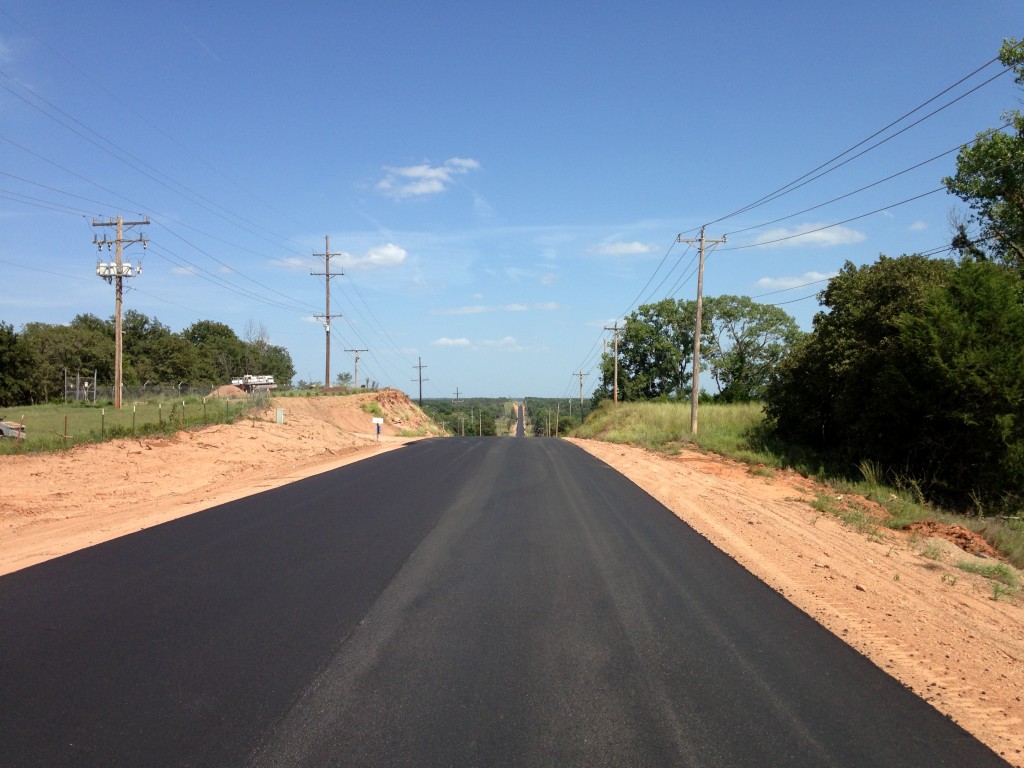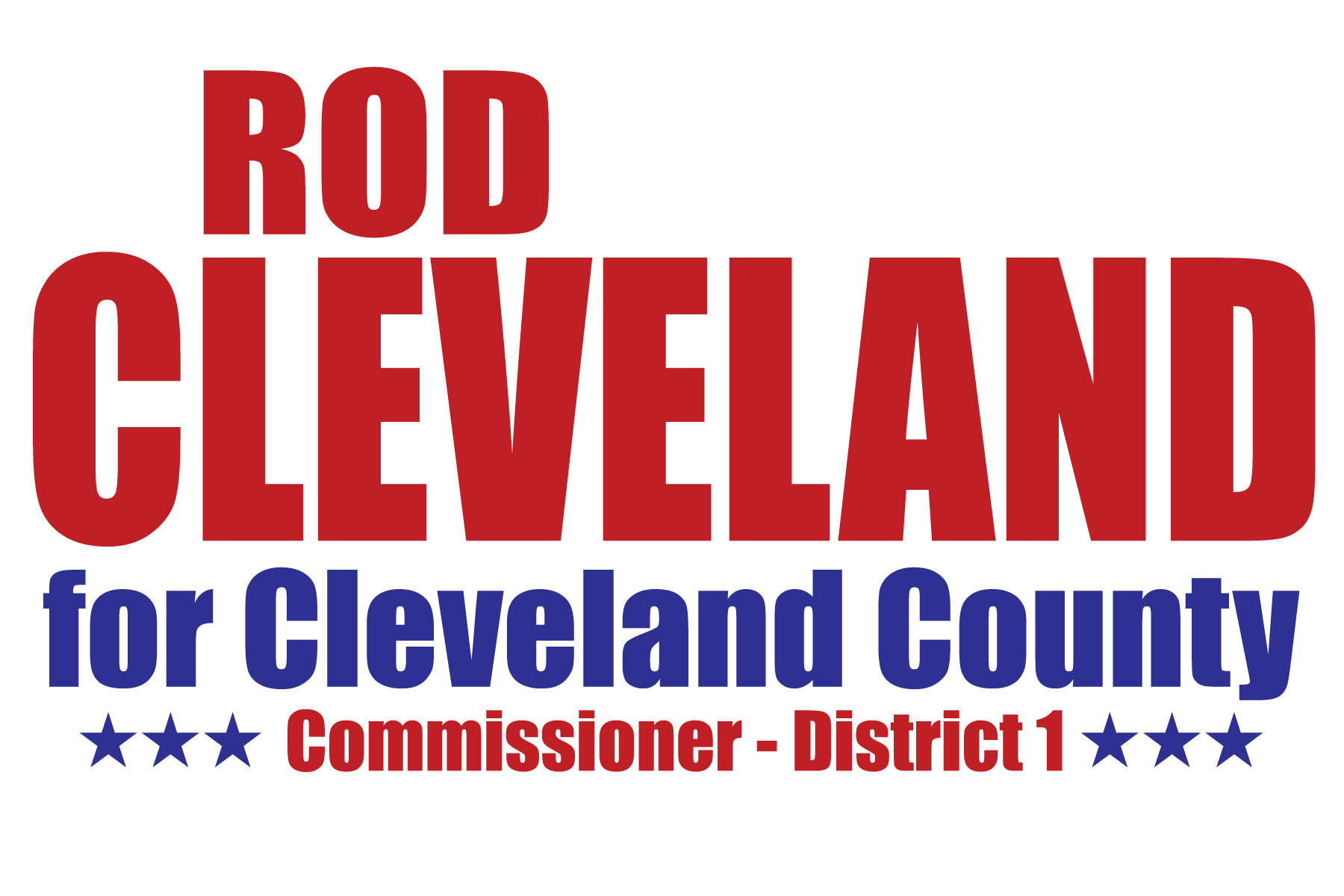With the looming $1.2 billion short fall in the Oklahoma State budget and the public secondary school system demanding raises for teachers, Oklahoma public road funding is in the crosshairs again. The public roads that will take the biggest hit is the county highways system. The county highway system consists of 83,273 miles which is 75% of the total Oklahoma highway system. County roads have been a target for repurposing user fees associated with gas/diesel, motor vehicle license and oil/gas gross production tax over the past three legislative sessions.

Stretch of NE 149th Street reconstructed and waiting on thermal plastic safety striping with trees removed from the right-away for safety.
County roads were created before state hood. Oklahoma is set up on a 4 mile square grid. This equates to 83,273 miles and allows the public in most cases to travel much shorter distances to get from one place to another. That also means that there are more railroad crossings (1,870 maintained by counties), more creeks and rivers to cross (13,579 bridges that is 61% of total bridges in Oklahoma), and roads in small cities/town (4,826 miles). These are roads that you travel on to work. These are roads that your children travel on to school. These are roads that farmers move their equipment and their products to market. These are the same roads that the oil and gas industry travel. Oil and gas production is the major revenue generator for Oklahoma families, business and government in Oklahoma.
County boundaries and government structure was created by the Oklahoma Constitution to be an extension of state government at a local level. Therefore, the state of Oklahoma is responsible for funding the 4 mile section line roads that makes up the county highway system. The state legislature in the early nineteenth century charged County Commissioners with the responsibility of maintaining the county highway system with the user fees generated from fuel, motor vehicle license, and gross production taxes. County Commissioners’ road maintenance funding formula has remained the same for 29 years. The only growth has been the natural increase in population and increase miles driven by Oklahomans like you.
In 2015, there was approximately $1.7 billion collected that make up the funding source for the Oklahoma public roads system in counties. It breaks down as the following:
- Motor Vehicle Fees/Taxes – $764,071,164
- Diesel fuel tax – $116,628,135
- Gasoline fuel tax – $305,513,068
- Gross Production Tax on Oil and Natural Gas production in the state – $542,074,272
The counties get apportioned each month for construction and maintenance for the Oklahoma public county highway system around 28.7% of the total taxes collected for 75% of the Oklahoma public roads. That breaks down by the following:
- Motor Vehicle Fees/Taxes – 29.28% (14.28% for restricted maintenance, 15% for large project construction only)
- Diesel fuel tax – 34.27%
- Gasoline fuel tax – 32.75%
- Gross Production Tax on Oil and Natural Gas production in the state 18.56%
Oklahoma public education is apportioned 84.3% of gross production tax on oil, 7.14% on natural gas, and 7.14% on ores & precious metals. Education is apportioned 36.2% from motor vehicle fees and taxes. The remaining goes to Oklahoma general revenue for the State Legislature to appropriate in the budget.
Motor Vehicle Taxes and Fees remaining apportionment:
- General Revenue (state budget) 29.84%
- State Transportation Fund 0.31%
- Local City Governments 3.1%
- Law Enforcement Retirement Fund 1.24%
- Wildlife Conservation Fund 0.03%
Motor Fuel Taxes remaining apportionment:
- State Transportation fund – Gasoline first $250,000 collected, Diesel first $83,333.33 collected
- High Priority State Bridge Fund – Gasoline 1.625%, Diesel 1.39%
- State Transportation Fund – Gasoline 63.75%, Diesel 64.34%
- Local Governments (cities/towns) – Gasoline 1.875%
Gross Production Tax on Ores & Precious Metals, Oil and Natural Gas:
- General Revenue – Ores & Metals 85.72%, Natural Gas 85.72%, Petro Gas Excise 82.634%, Natural Gas Excise 82.634%
- Tourism Capital Fund 1.427% (oil)
- Conservation Commission Infrastructure Fund 1.427% (oil)
- Community Water Infrastructure Fund 1.427% (oil)
- Corporation Commission Plugging Fund 10.526% (from each Petro & Natural Gas Excise)
- Interstate Oil Compact Fund 6.84% (from each Petro & Natural Gas Excise)
The county public highway system has taken disproportionate cuts in funding compared to other state agencies including education.
In 2014, the Emergency and Transportation Revolving fund lost 40% ($10,000,000) of real money. This fund is used by counties to borrow money for emergencies and transportation projects until funds are available for reimbursement. In 2015, 12% ($16,000,000) of CIRB (County Improvements for Roads and Bridges) program fund growth with a cap at $120 million. That will equate to nearly $200 million loss in funding over the next 8 year transportation plan. Also, in 2015 $50 million was repurposed to the general fund that has causes project cancelations and delays. Also in 2015, legislation was passed that capped the Motor Vehicle Taxes and Fees apportionment to county public transportation maintenance accounts to 2015 receipts. This fund has been has been growing year over year modestly, but that modest growth over 10 years will mean an estimated loss to county public transportation funding of more than $192 million.
Now in the 2016 legislative session, there are several bills that further cap the motor vehicle, motor fuel, and gross production tax on oil and natural gas. The legislation filled range from 11% reduction by capping these revenue funds to 2013 receipts, another caps the motor vehicle tax and fees that go to the County Improvements for Roads and Bridges at $99 million which is down from the previous cap of $120 million (17.5% cut).
